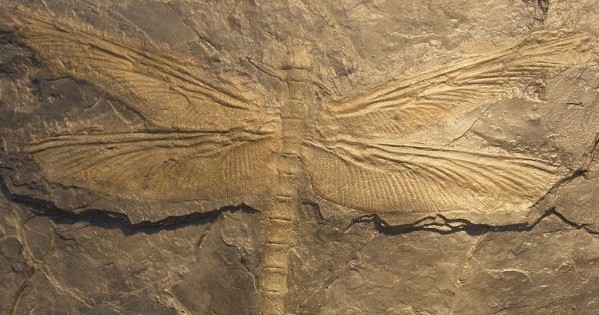
We Americans like things big—big pumpkins, big TV sets, big servings. We like big cars. We like big dogs, to judge by the massive mastiff I once met on a Metro bus, sitting at the feet of his mountainous mistress.
But we like our insects small, if at all. So possibly we would not have loved the Meganeura monyi had we been around to swat it. Here was a dragonfly with a wingspan nearly a yard wide. It was the largest insect that ever lived.
During the Meganeura’s time—running from the Carboniferous Period into the early Permian Period, some 359-300 million years ago—other sentient beings were also bigger. You had a 10-foot-long centipede. You had spiders the size of a dinner plate. You had froggy-type amphibians that were two feet long.
Why so big? The simple answer: more oxygen in the atmosphere made bigger possible. And if you were a predator, bigger was fitter. (The Meganeura was a predator, chomping on other insects and even on amphibians.) Our atmosphere comprises about 21 percent oxygen with the rest being mostly nitrogen. During the Carboniferous Period oxygen mounted to about 35 percent. So writes Peter D. Ward in Out of Thin Air.
So what’s to prevent bugs from becoming as big as buildings? Again, oxygen. Insects need oxygen, just as we do. For them as for us, carbon dioxide is a waste product. But insects have no lungs. They have tubes called tracheae into which oxygen enters. The air ends in a moist cell called a tracheole. Here oxygen dissolves and enters the cell while carbon dioxide exits through the tube. This might be called gas exchange, or it might be called insect breathing. It is a passive system, and today the tissues of a big-bodied bug would go begging for oxygen. It could not live.
Oxygen is hyper-reactive; it wants to combine with iron, sulfur, carbon, etc. The oxygen in our atmosphere is free oxygen, oxygen uncombined. So why was there more of this free oxygen in the atmosphere 300 million years ago (as most, though not all scientists conclude)?
At the time, earth’s land mass was one big continent—call it Pangaea. The earth was warm and rainy and swampy. Trees had evolved but with shallow roots; they tended to fall over. Their lignin—the hard stuff of wood—just sat there and over the millennia sank and got buried, but without rotting. Most bacteria and fungi that dine upon lignin, breaking it down into simpler elements, had yet to evolve. With these complex, unbroken-down molecules, oxygen declined to combine. Vast swamps and wet forests were buried in a reduced (unoxidized) state. And so coal—composed mainly of carbon—was made.
Meanwhile, oxygen was produced by the usual suspects: plants and photosynthesizing cyanobacteria. More and more of it entered the atmosphere as free oxygen. The oxygen content of our air has never been constant or steady or stable. Sometime after the Age of Big, oxygen levels began to sink. This was a disaster for numerous bugs and other beings. But that is another story. This story belongs to the Meganeura, that gigantic and—to judge by its fossil—gorgeous dragonfly.

